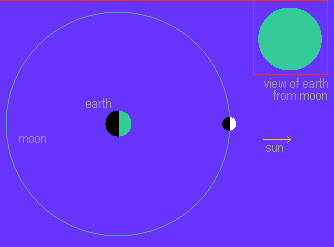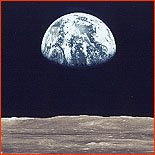 That's right! One lunar month, or 29.5 Earth days.
That's right! One lunar month, or 29.5 Earth days. It's relatively easy to understand why the lunar month and the "Earth" month are the same length. When the moon is full (as seen from Earth) it's on the side of the Earth away from the sun. This means that the Earth is between the moon and the sun. As seen from the moon, the Earth is "new"—only its night side is visible. Conversely, when the moon is "new," it's between the Earth and the sun, and the Earth is "full."
It is quite obvious that the moon orbits the Earth, right? Well, did you know that the sun pulls more than twice as hard on the moon as the Earth does? So why doesn't the sun yank the moon from Earth's pull?

The answer is because the moon is effectively orbiting the sun! The Earth is really just causing a perturbation (in other words, a variation, or a deflection) of the moon's path as the moon travels around the sun. This perturbation is a very regular orbit around the Earth.
 By the way, the footage of the Earth rising over the moon's horizon
was taken by an astronaut while he was orbiting the moon and was not
taken from the moon's surface.
By the way, the footage of the Earth rising over the moon's horizon
was taken by an astronaut while he was orbiting the moon and was not
taken from the moon's surface.The next lunar puzzler...
Photo: NASA
Explore the Moon | Lunar Puzzlers | Last Man on the Moon
Hear the Space Pioneers | Origins | Resources
Transcript | Site Map | To the Moon Home
Editor's Picks | Previous Sites | Join Us/E-mail | TV/Web Schedule
About NOVA | Teachers | Site Map | Shop | Jobs | Search | To print
PBS Online | NOVA Online | WGBH
© | Updated November 2000